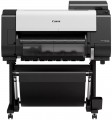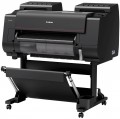Sheet printing time
Approximate time taken by the plotter to print one sheet.
This indicates for the paper size that the machine was originally designed for (see "Paper Size"). And it is approximate because it is usually given for optimal or almost optimal printing conditions: low quality and resolution, relatively simple images, etc. So the actual print time of the sheet may differ from the claimed one in one direction or another, depending on the operating parameters — starting from the mentioned quality and resolution to the type of media. However, according to the figures indicated in the specs, it is quite possible to evaluate different models and compare them with each other: the difference in the claimed time, usually, will proportionally correspond to the difference in the actual printing speed.
It is also worth noting that this time is usually indicated by the duration of the printing process itself — from the capture of the sheet by the feeder to the output of the completed print from the device. Interruptions inevitably occur between printing individual sheets, so that the total printing time is longer than the printing time of a sheet multiplied by the number of sheets. For example, a device with a time consumption of 36 sec per sheet theoretically should print about 100 sheets per hour (1 h = 3600 s, 3600/36 = 100), but in fact such a plotter usually produces about 70 – 75 sheets in this time.
Drop volume
The smallest drop volume of ink that can be produced by the printhead of an inkjet or similar plotter (see "Product Type").
This parameter is directly related to the print resolution (see “Maximum resolution”): the more dots per inch, the smaller the separate dots and, accordingly, the drops should be. At the same time, models with the same dpi number may differ slightly in this parameter. In such cases, it should be assumed that a smaller droplet volume potentially provides better print quality, with more accurate reproduction of fine lines and borders between individual areas of the image, however, such features accordingly affect the price of the device.
Number of cartridges
The number of individual cartridges the plotter needs to operate.
Each cartridge is responsible for its base colour used in printing. Monochrome plotters (see "Output Type"), by definition, use only one cartridge, for black colour and for such devices this parameter is usually not specified at all. But in colour printing, where all available shades are obtained by mixing basic colours, the number of such colours (and, accordingly, cartridges) can be different.
The most modest of modern colour plotters are designed to work with
4 or 5 cartridges. The first option corresponds to the CMYK colour scheme with 4 basic colours — this is the minimum required for full colour printing. In turn, 5 cartridges usually mean a CMYK colour scheme, supplemented by a separate supply of black ink for monochrome images — this allows you not to waste consumables for such images that may be needed for colour prints, and also to print monochrome even with empty colour cartridges, and vice versa.
In general, these sets of basic colours are inexpensive, while they are able to provide fairly good quality prints; so plotters for 4 – 5 cartridges are very popular nowadays. However, the use of additional basic colours can significantly increase the quality of the image, primarily the reliability of colour reproduction. Thereby, advanced plotters can provide a larger number of cartridges —
6 – 10, and s
...ometimes more. Such devices are quite expensive and difficult to maintain, but they are indispensable for printing materials with high requirements of colour quality.Cartridge model
Models of cartridges used in the plotter. With this info, you can easily find original consumables for the device.
Built-in memory
The amount of built-in memory provided in the design of the plotter.
Such memory is used to store various service data: print tasks, settings profiles, etc. Due to this, the plotter becomes more "independent": for example, many models allow you to continue printing even when the master PC is turned off.
We emphasize that in this case we are talking about solid-state flash memory, which is used mainly for "operational" service information. The capacity of such memory is relatively low, it is measured in megabytes; but in addition to it, the design may include a larger storage capacity — usually a traditional hard drive. For more information about it, see "Drive Capacity".
Noise level
The maximum noise level produced by the plotter during operation. The lower this indicator, the less inconvenience to others the device will create. At the same time, in modern plotters, the noise level usually does not exceed 60 dB, which is comparable to a TV set at an average volume; and many of them do not "reach" even up to 50 dB, corresponding to a quiet conversation at a distance of 2-3 m. And if we also take into account the fact that plotters are usually used in industrial premises, then we can say that in most cases this indicator does not play a significant role.
Power consumption
Rated power consumption of the plotter. Usually specified by the maximum value — for the print mode, when the device requires the most power.
The heavier and more performant the device, the higher its power consumption in general. At the same time, models that are similar in performance may differ in this indicator. And here it is worth proceeding from the fact that a more energy-efficient unit usually costs more, but with intensive use, this difference can quickly pay off due to energy savings.
In addition, the power consumption may be necessary for special electrical calculations — for example, determining the necessary parameters of a voltage stabilizer, a backup generator, etc.
Weight
The total weight of the plotter is usually listed without ink and paper. You should pay attention to this parameter foremost when choosing desktop models (see "Placement"): modern plotters are quite massive, which puts forward corresponding requirements for stands for them.

